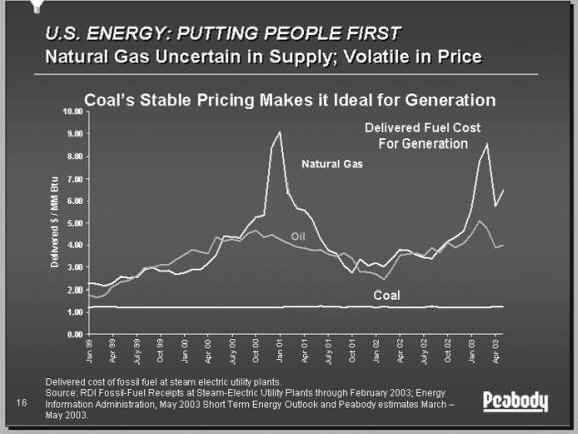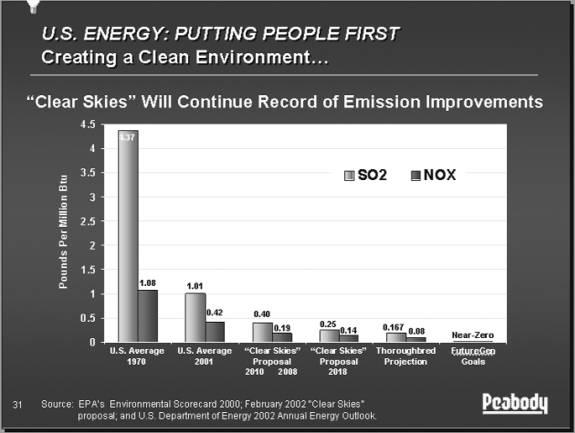![]()
U.S. Energy Policy
|
Fred Palmer |
Fredrick Palmer, Executive VP, Legal and External Affairs, Peabody Energy addressed the Rocky Mountain Coal Mining Institute on U.S. Energy Policy: Putting People First. A Supply Side Energy Policy for the American People. Decision makers must balance the needs of average Americans with the need for a strong economy, a clean environment and a secure nation. Events of recent years – terrorist acts, multiple energy crises, and a global focus on sustainable development – magnify the need to balance these principals. Coal – domestic, abundant, affordable, and increasingly clean – meets these needs like no other energy source, according to Palmer.
Today’s issues are a legacy of the 1990’s with:
• Reliance on natural gas to meet new energy and electricity needs;
• Neglect of U.S. energy/electricity infrastructure;
• Too little understanding and care regarding the harsh effects that high energy prices have on the economy and the individual;
• Hostility toward more than half of U.S. electricity based – coal fueled generation.
Palmer assessed U.S. energy needs and resources:
• America’s coal is the most abundant domestic energy resource of any nation in the world;
• Electricity is by far the fastest growing form of U.S. energy;
• Coal fuels more than half of America’s generation and was the fastest growing energy source in the world in 2002;
• Natural gas is more limited than policymakers realize;
• We should expand utilization of America’s existing coal fueled plants, develop new coal fueled capacity, retrofit idled capacity, and convert gas fired generation to coal.
High energy costs drain industry’s jobs and lives. Palmer quoted Stewart Smith, Vice President of Operations, Hanson Permanent Cement of Cupertino, California. “In 2002, our power bill was approximately $9 million. Our power bill for 2003 will increase by around $5 million for an expected total of $14 million. We currently do not have the sales volume, the productivity, or the margins to remotely support such an increase. Regrettably, we must implement a lay off of a large percentage of our workforce.” Robert Liuzzi, CEO, CF Industries said, “High natural gas prices present the most serious threat to the fertilizer sector and to farmers in general, since the energy shocks of the 1970’s.”
Coal is vital for a healthy economy, according to Palmer:
• 20 of the 25 lowest cost steam generating plants in America were fueled by coal in 2001.
• The ten states that use the highest percentage of coal enjoy electricity rates 40% lower than the ten states that use the largest percentage of other fuels.
• A recent Penn State study shows that the average annual benefit of coal fueled electricity to the U.S. economy is $411 billion per year.
• The new Klein-Kenney study shows that removing coal from the U.S. energy mix would lead to at least 14,000 to 25,000 premature deaths a year and perhaps as many as 100,000.
Palmer said that high energy costs threaten lives and lifestyles.
• During the energy crisis of 2000-2001, middle class Americans faced average energy costs equaling 4.6% of their incomes. Low income Americans were forced to pay 19.5% of their income on home energy costs. Those who use natural gas used 29% of their income for energy.
• A 2002 winter survey of 19 states and the District of Columbia showed that 4.3 million low income households were at risk of having power or gas shut off, because they couldn’t afford to pay.
Competing fuels face severe limitations:
• Oil – small and declining share of electricity generation;
• Hydro – limited capacity, operating at nature’s whim;
• Nuclear – running flat out and limited by security and disposal fears;
• Renewables – niche markets, uncompetitive for base load generation;
• Natural gas – short supplies and volatile, high price.
There is an imbalance in U.S. gas supply and demand. U.S. gas demand has been stable for 30 years. In 1977, the annual U.S. gas consumption was 21.1 trillion cubic feet. In 2000, it was 23.5 trillion cubic feet. U.S. gas production works hard to stay even. In 1970, it was 21.1 trillion cubic feet, and in 2000, was 19.0 trillion cubic feet. The Energy Information Administration projects an alarming growth in gas demand from 23.5 trillion cubic feet in 2000 to 34.9 trillion cubic feet in 2025. Palmer said that the record low storage of gas threatens U.S. energy future. In gas math, the equation simply doesn’t compute and there will likely be a summer to summer shortfall between 2002 and 2003 of 1065 Bcf. A repeat of this winter’s economy and weather next year will mean:
• No gas by February
• Further demand destruction of the industrial sector and/or
• Soaring gas prices
Natural gas is therefore uncertain in supply and volatile in price.
On the other hand, coal’s stable pricing makes it ideal for generation (See Figure 1 delivered costs of fossil fuel in steam electric utility plants”. “The solution, it’s right beneath our feet,” said Palmer. “Coal is America’s most abundant fuel.” Palmer referred to Peabody’s 80 million ton per year, North Antelope Rochelle Mine as an example.

Figure 1
Coal accounts for 85% of U.S. fuel resources and 51.8% of electricity generation. It should also be noted that coal based electricity fuels sustained prosperity and wealth expands in the countries with greater electricity use. Palmer reviewed changes in coal fueled electricity and emissions since 1970. Coal use has gone up 211% and electricity from coal has increased 179%. Meanwhile NOx emissions have increased 18%, SO2 emissions reduced 32%, and PM10 emissions reduced 86%. Palmer said that the economics are compelling for new coal generation.
One of the things that must be done is the development of mine mouth generation. Palmer gave an example of the Thoroughbred Energy Campus being developed by Peabody. This is a plant in western Kentucky, which will have two 750-mw units, state of the art environmental controls, and have a 5 million ton a year onsite mine. It will be a joint venture to own and operate the plant and the mine and permitting continues. Peabody is actively seeking partners and customers and this will be a template for a sister project Prairie State. To create a clean environment “Clear Skies” will continue the record of emissions improvement (See Figure 2).

Figure 2
The vision of future generation will be demonstrated in FutureGen, which will advance key energy and environmental goals.
• President Bush has outlined a vision of hydrogen as a future energy source.
• H2 is viewed as climate friendly and abundant.
• The FutureGen initiative includes a proposed $1 billion full scale hydrogen from coal research project.
• Coal would fuel the generating plant, produce hydrogen and capture CO2.
• Coal gasification.
• Hydrogen production from coal to fuel the hydrogen economy.
• Capture and sequestration of carbon dioxide.
• Electricity production with near zero emissions.
The FutureGen Alliance recently responded to the Department of Energy’s FutureGen Initiative. Members currently include American Electric Power, Synergy, CONSOL Energy, Connecticut Energy, North American Coal Corp., PacifiCorp, Peabody Energy, RAG American Coal, Southern Company, and TXU. The alliance is open to others.
Palmer concluded by saying that energy crises create bipartisan support for U.S. coal and gave the following quotations:
“If on the one hand we have encouraged, as we have, very significant growth in domestic demand for natural gas – but are very readily constrained by our ability to increase supply – then something has got to give and what is giving, of course, is price,” Federal Reserve Chairman Alan Greenspan.
“It’s in our nation’s natural security interests that we become less dependant on for
eign sources of energy…we need to use coal,” President George W. Bush.
“We are literally sitting on the resources that we need to be energy independent. My Administration will invest $15 billion over 10 years in new coal technologies,” Presidential Candidate Joseph Lieberman. cl
This
article is protected by United States copyright and other intellectual property
laws. The article may not be reproduced, rewritten, distributed, redisseminated,
transmitted, displayed, published or broadcast, directly or indirectly, in any
medium without the prior permission of Coal Leader, Inc. Copyright 2003, Coal
Leader, Inc. All rights reserved.